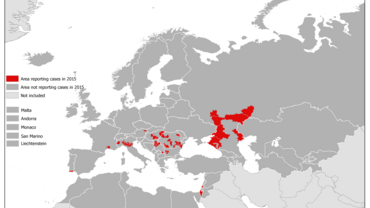Epidemiological update: West Nile virus transmission season in Europe, 2015
Since the 5 June 2015, ECDC has published on its website an interactive atlas presenting weekly updates on spatial distribution of West Nile fever human cases in the European Union and neighbouring countries.
Since the 5 June 2015, ECDC has published on its website an interactive atlas presenting weekly updates on spatial distribution of West Nile fever human cases in the European Union and neighbouring countries. In the EU, reported cases are neuro-invasive and non neuro-invasive autochthonous West Nile fever cases meeting laboratory criteria as per the EU case definition (Directive 2008/426/EC). Outside the EU, all non-imported cases are included.
The first case of West Nile fever was reported on 23 June 2015 from Sofia in Bulgaria. Since the beginning of the 2015 transmission season, 108 cases of West Nile fever in humans have been reported in the EU, 60 in Italy, 18 in Hungary, 19 in Romania, seven in Austria, two in Bulgaria, one in France and one in Portugal. In neighbouring countries, 193 cases have been detected in Israel (125), the Russian Federation (39), Serbia (28) and Palestine* (1).
In the EU, the highest numbers of cases have been reported from Italy, where provinces with high population were affected, particularly Milano, a province without previous history of local transmission. In Hungary and Romania the transmission season was rather similar to the 2014 season. The capitals of both countries were affected but more cases were detected in Hungary (18 in 2015 vs 11 in 2014) and less counties were affected in Romania (9 in 2015 vs 14 in 2014). For the second consecutive year, cases were reported in Austria (Vienna area) where mandatory reporting of West Nile fever cases was implemented this year. In Bulgaria, cases were detected in Sofia area; the previous reported cases were detected in 2012 in Burgas, along the Black sea coast.
One case in department of Gard, France and in the Algrave region, Portugal were detected at the same time as equine cases. Previous human cases in France and Portugal were reported in 2003 and 2010, respectively.
No human cases were detected in Greece for the first year since 2010.
All the cases detected in the EU have been reported into TESSy through the real time reporting system implemented since 2014.
Most of the cases in the neighbouring countries occurred in Israel reporting the highest number of cases since the implementation of the West Nile maps in 2011. Cases were still reported in November. For the Russian Federation, West Nile fever transmission was similar to previous seasons, with 39 cases in seven affected areas this year compared with 29 cases in eight areas in 2014. Serbia was less affected this year, with 28 cases reported from seven areas compared with 76 cases detected in 2014 from nine areas.
Since 31 October, no recent cases have been reported in the countries of the European continent. With the decreasing activity of the mosquito populations, the season of West Nile virus transmission to humans is now coming to an end in Europe. ECDC publishes its last weekly update of the WN fever maps on Friday 20 November closing its seasonal monitoring of West Nile virus transmission for 2015.
* This designation shall not be construed as recognition of a State of Palestine and is without prejudice to the individual positions of the Member States on this issue
Related data
Related content
Disease page
West Nile virus infection
West Nile virus (WNV) infection is a mosquito-borne zoonosis. The virus is transmitted among birds via the bite of infected mosquitoes and incidentally humans and other mammals may become infected.






